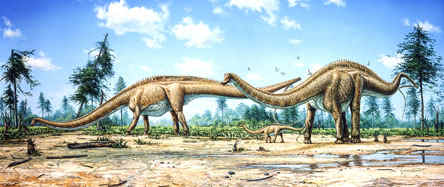
(Copyright Michael Skrepnick, 1998)

Dinosaurs are animals that evolved into many sizes and shapes. Dinosaurs were and are quite diverse, and often one person will think of an animal like a long-necked sauropod, while another person will think of a large, fierce meat-eater like Tyrannosaurus rex. It should be clear then that the term "dinosaurs", or the scientific version "Dinosauria", is describing a diverse group of animals with widely different modes of living. The term was invented by Sir Richard Owen in 1842 to describe these "fearfully great reptiles", specifically Megalosaurus, Iguanodon, and Hylaeosaurus, the only three dinosaurs known at the time. The creatures that we normally think of as dinosaurs lived from late in the Triassic period (about 225 million years ago) until the end of the Mesozoic era (about 65 million years ago); but actually they live on today as the birds.

Running Deinonychus, copyright B. Cunningham 1995
The term "dinosaur" has had a long history of misrepresentation. A few simple points must be kept in mind when discussing these animals:
|
Click on these buttons to learn more about dinosaurs Select Systematics to learn about specific dinosaur groups! |
UCMP Special Exhibit: DinobuzzExplore current and exciting research into the biology of dinosaurs. Were they warm-blooded? Why did they go extinct? Are dinosaurs related to birds, or are they reptiles (or are both true)? All this and more! |
UCMP Special Exhibit: Dilophosaurus!Visit a very special account of the discovery and reconstruction of this dinosaur. The exhibit is narrated by UCMP's own Sam Welles, who discovered Dilophosaurus! |
UCMP Special Exhibit: T. rex ExpoNo dinosaur is so famous nor so feared as Tyrannosaurus. UCMP assembled this exhibition in conjunction with the unveiling of its free-standing skeletal mount. |

Weishampel, D.B., P. Dodson, and H. Osmolska (eds.). 1990. The Dinosauria. University of California Press: Berkeley. 733p. Simply put, the definitive text on dinosaurs. A bit technical for beginners, but exhaustive in detail; a "must have".
Norell, M.A., E.S. Gaffney, and L. Dingus. 1995. Discovering Dinosaurs at the American Museum of Natural History. Nevraumont Publishing Company, Inc.: New York. 204p. A current update of dominant thinking in dinosaur paleontology. Targetted for the layperson (with a good review of cladistics), but useful for all.
Norman, D. 1985. The Illustrated Encyclopedia of Dinosaurs. Crescent Books: New York. 208p. 10 years after its release, still the best popular book on dinosaurs, for all ages.
Padian, K. and D. Chure (eds.). 1989. The Age of Dinosaurs: Short Courses in Paleontology Number 2. The Paleontological Society. 210p. A book outlining for teachers how to run a course about dinosaurs.

